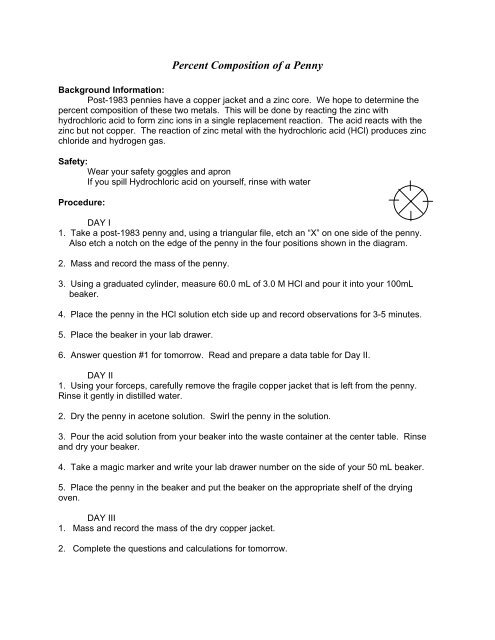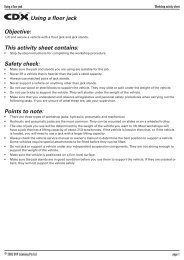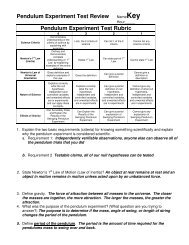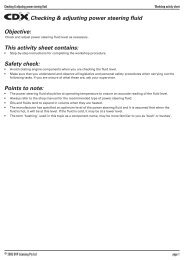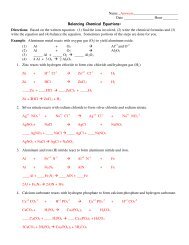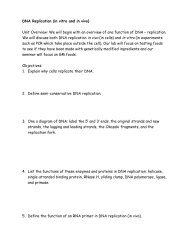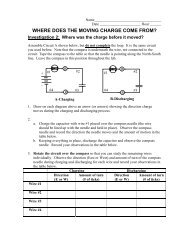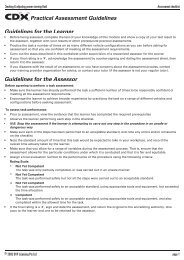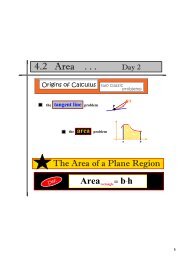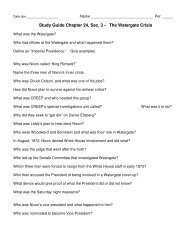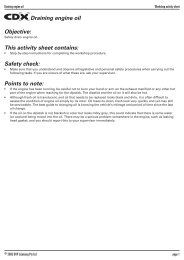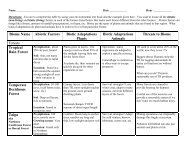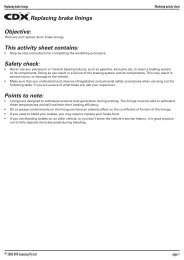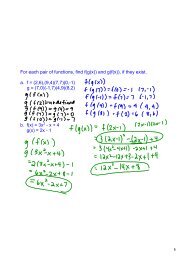Lab: Percent Composition of a Penny
Lab: Percent Composition of a Penny
Lab: Percent Composition of a Penny
You also want an ePaper? Increase the reach of your titles
YUMPU automatically turns print PDFs into web optimized ePapers that Google loves.
<strong>Percent</strong> <strong>Composition</strong> <strong>of</strong> a <strong>Penny</strong><br />
Background Information:<br />
Post-1983 pennies have a copper jacket and a zinc core. We hope to determine the<br />
percent composition <strong>of</strong> these two metals. This will be done by reacting the zinc with<br />
hydrochloric acid to form zinc ions in a single replacement reaction. The acid reacts with the<br />
zinc but not copper. The reaction <strong>of</strong> zinc metal with the hydrochloric acid (HCl) produces zinc<br />
chloride and hydrogen gas.<br />
Safety:<br />
Wear your safety goggles and apron<br />
If you spill Hydrochloric acid on yourself, rinse with water<br />
Procedure:<br />
DAY I<br />
1. Take a post-1983 penny and, using a triangular file, etch an “X” on one side <strong>of</strong> the penny.<br />
Also etch a notch on the edge <strong>of</strong> the penny in the four positions shown in the diagram.<br />
2. Mass and record the mass <strong>of</strong> the penny.<br />
3. Using a graduated cylinder, measure 60.0 mL <strong>of</strong> 3.0 M HCl and pour it into your 100mL<br />
beaker.<br />
4. Place the penny in the HCl solution etch side up and record observations for 3-5 minutes.<br />
5. Place the beaker in your lab drawer.<br />
6. Answer question #1 for tomorrow. Read and prepare a data table for Day II.<br />
DAY II<br />
1. Using your forceps, carefully remove the fragile copper jacket that is left from the penny.<br />
Rinse it gently in distilled water.<br />
2. Dry the penny in acetone solution. Swirl the penny in the solution.<br />
3. Pour the acid solution from your beaker into the waste container at the center table. Rinse<br />
and dry your beaker.<br />
4. Take a magic marker and write your lab drawer number on the side <strong>of</strong> your 50 mL beaker.<br />
5. Place the penny in the beaker and put the beaker on the appropriate shelf <strong>of</strong> the drying<br />
oven.<br />
DAY III<br />
1. Mass and record the mass <strong>of</strong> the dry copper jacket.<br />
2. Complete the questions and calculations for tomorrow.
Questions Answer in complete sentences<br />
SHOW ALL MATH FOR CREDIT! INCLUDE UNITS & SIG FIGS IN ALL ANSWERS!<br />
1. Write the balanced equation for the reaction. Include (states) .<br />
2. Calculate the mass <strong>of</strong> zinc found in the penny.<br />
3. Calculate the mass <strong>of</strong> copper in the penny.<br />
4. Calculate the percent zinc and the percent copper in a penny.<br />
5. Record the class average for percent zinc.<br />
6. List at least four sources <strong>of</strong> error and how they would specifically affect your results.<br />
7. Examine the ingredients <strong>of</strong> a cola soda such as Coke or Pepsi. Could you safely store a<br />
cola soda like Coke or Pepsi in a zinc container? In a copper container? Explain your<br />
answer based on the ingredients.<br />
8. a) Using your balanced equation from #1, determine the number <strong>of</strong> moles <strong>of</strong> HCl needed<br />
to react with 2.00 g <strong>of</strong> zinc metal.<br />
b) How many moles <strong>of</strong> zinc chloride are produced?<br />
c) How many gram <strong>of</strong> hydrogen gas are produced?<br />
d) What is happening to the potential energy <strong>of</strong> the system? How do you know?<br />
9. a) Using your balanced eqation from #1, which element is oxidized in the reaction?<br />
Explain.<br />
b) Which element is reduced? Explain.


